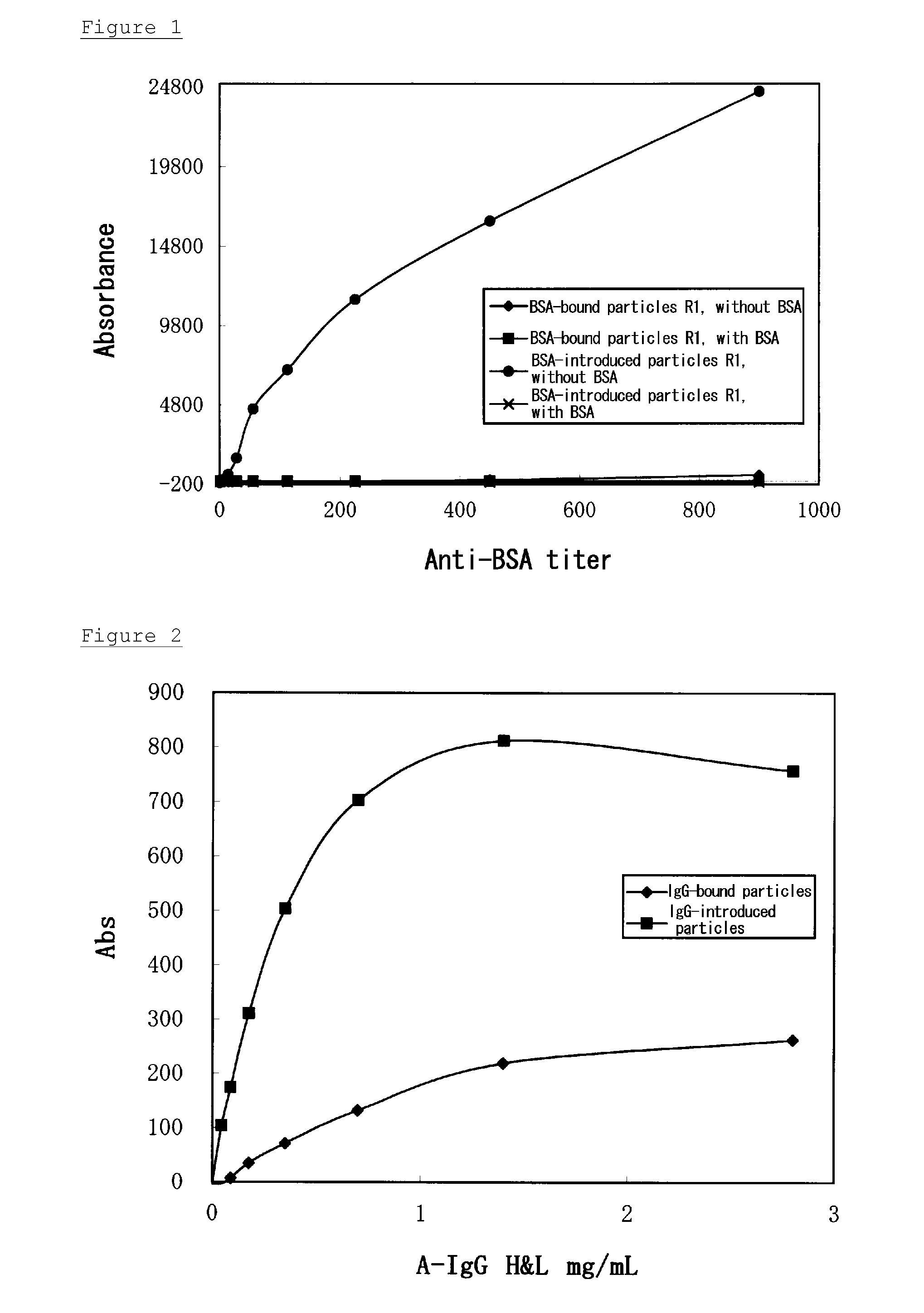Reagent and method for immunological analysis
- Summary
- Abstract
- Description
- Claims
- Application Information
AI Technical Summary
Benefits of technology
Problems solved by technology
Method used
Image
Examples
example 1
Preparation of Reagent for Measuring Anti-Bovine Serum Albumin (BSA) Antibody
(1) Preparation of BSA-Introduced Latex Particles
[0050]After 40 mmol of styrene, 4 mmol of hexadecane, 200 mg of BSA, 0.8 mmol of CH2═C(CH3)COO(CH2CH2O)23CH3 (NK ester M-230G; Shin-nakamura Chemical Co. Ltd.), 0.4 mmol of ascorbic acid, and 20 g of water were mixed, the mixture was sonicated [output: 80%, pulse: 50%, UH-300 (SMT Co., Ltd.)] in an ice bath for 15 minutes. The whole was transferred to a three-necked flask, and nitrogen gas was bubbled through the whole for 15 minutes while stirring at 100 rpm. Further, 0.4 mmol of H2O2 was added, and polymerized at 30° C. or 60° C. for 6 hours while stirring at 200 rpm to prepare BSA-introduced latex particles. The average particle sizes of the resulting BSA-introduced latex particles were 0.109 μm (polymerization at 30° C.) and 0.121 μm (polymerization at 60° C.)
(2) Preparation of Suspension of BSA-Introduced Latex Particles
[0051]With respect to 1 mL of the ...
example 2
Measurement of Standard Solution of Anti-BSA Antibody
(1) Preparation of Standard Solution of Anti-BSA Antibody
[0054]An anti-BSA antibody (Rabbit Anti cow albumin; DAKO, 900 units) was serially diluted twofold with physiological saline to prepare a series of serial dilutions of a standard anti-BSA antibody having concentrations of 900, 450, 225, 113, 56, 28, 14, and 7 units.
(2) Measurement of Standard Solution of Anti-BSA Antibody
[0055]After 90 μL of buffer A or B prepared in Example 1(3) was mixed with 15 μL of each of the dilution series, and incubated at 37° C. for a predetermined period of time, 90 μL of the suspension of BSA-introduced latex particles prepared in Example 1(2) was further added and stirred. From the last addition, absorbances at wavelengths of 800 nm and 570 nm were measured for 5 minutes. The difference between a variation of absorbance (i.e., an amount of change in absorbance) at 570 nm and a variation of absorbance at 800 nm was regarded as a variation of abso...
example 3
Measurement of Human Sera Using Reagent for Measuring Anti-BSA Antibody
[0062]In this Example, the procedures described in Example 2(2) were repeated, except that five human serum samples (Nos. 1 to 5) as normal samples and three human serum samples (Nos. 6 to 8) as nonspecific samples were used instead of the dilution series of a standard anti-BSA antibody. The nonspecific samples nonspecifically reacted with a suspension of latex particles to which BSA was bound (i.e., BSA-bound latex particles), but did not react with a suspension of latex particles to which BSA was not bound.
[0063]The results are shown in Table 3.
[0064]As shown in Table 3, the normal serum samples (Nos. 1 to 5) and the nonspecific serum samples (Nos. 6 to 8) did not react with the suspension of BSA-introduced latex particles. However, the suspension of BSA-bound latex particles strongly reacted with the nonspecific samples when the buffer without BSA (buffer A) or the buffer in which 0.5% BSA was suspended (buffe...
PUM
 Login to View More
Login to View More Abstract
Description
Claims
Application Information
 Login to View More
Login to View More - R&D
- Intellectual Property
- Life Sciences
- Materials
- Tech Scout
- Unparalleled Data Quality
- Higher Quality Content
- 60% Fewer Hallucinations
Browse by: Latest US Patents, China's latest patents, Technical Efficacy Thesaurus, Application Domain, Technology Topic, Popular Technical Reports.
© 2025 PatSnap. All rights reserved.Legal|Privacy policy|Modern Slavery Act Transparency Statement|Sitemap|About US| Contact US: help@patsnap.com

